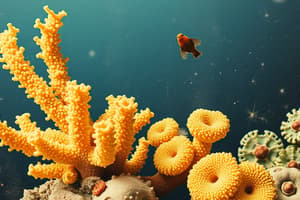Podcast
Questions and Answers
Which type of cells are responsible for producing a sponge's skeleton?
Which type of cells are responsible for producing a sponge's skeleton?
- Choanocytes
- Amoebocytes (correct)
- Osculum cells
- Porocytes
What is the name of the large opening through which water leaves the spongocoel in a sponge?
What is the name of the large opening through which water leaves the spongocoel in a sponge?
- Ostium
- Porocyte
- Osculum (correct)
- Choanocyte
Which cell type in sponges can transform into any other cell type required by the sponge?
Which cell type in sponges can transform into any other cell type required by the sponge?
- Porocytes
- Choanocytes
- Flagellated cells
- Amoebocytes (correct)
What is the role of choanocytes in a sponge's feeding process?
What is the role of choanocytes in a sponge's feeding process?
Which structure surrounds the small pores (ostia) through which water enters a sponge?
Which structure surrounds the small pores (ostia) through which water enters a sponge?
What is the composition of a sponge's skeletal system made of flexible protein fiber?
What is the composition of a sponge's skeletal system made of flexible protein fiber?
In which part of a sponge would you find flagellated choanocytes lining the interior?
In which part of a sponge would you find flagellated choanocytes lining the interior?
What is the function of amoebocytes in sponges?
What is the function of amoebocytes in sponges?
Which type of cells open and close to control water flow into a sponge through its pores?
Which type of cells open and close to control water flow into a sponge through its pores?
What are needle-like structures found in a sponge's skeletal system called?
What are needle-like structures found in a sponge's skeletal system called?
Flashcards are hidden until you start studying
Study Notes
Sponge Cells and Structure
- Amoebocytes are responsible for producing a sponge's skeleton.
- Osculum is the name of the large opening through which water leaves the spongocoel in a sponge.
- Amoebocytes are totipotent, meaning they can transform into any other cell type required by the sponge.
- Choanocytes create water currents that draw food particles into the sponge.
- Porocytes surround the small pores (ostia) through which water enters a sponge.
- Spongin, a flexible protein fiber, is the composition of a sponge's skeletal system.
- Spongocoel is the central cavity of a sponge where flagellated choanocytes line the interior.
- Amoebocytes play various roles in sponges, including transporting food, producing reproductive cells, generating skeletal elements, and repairing injuries.
- Porocytes are the cells responsible for opening and closing to control water flow into a sponge through its pores.
- Spicules are needle-like structures found in a sponge's skeletal system, providing support and protection.
Studying That Suits You
Use AI to generate personalized quizzes and flashcards to suit your learning preferences.




